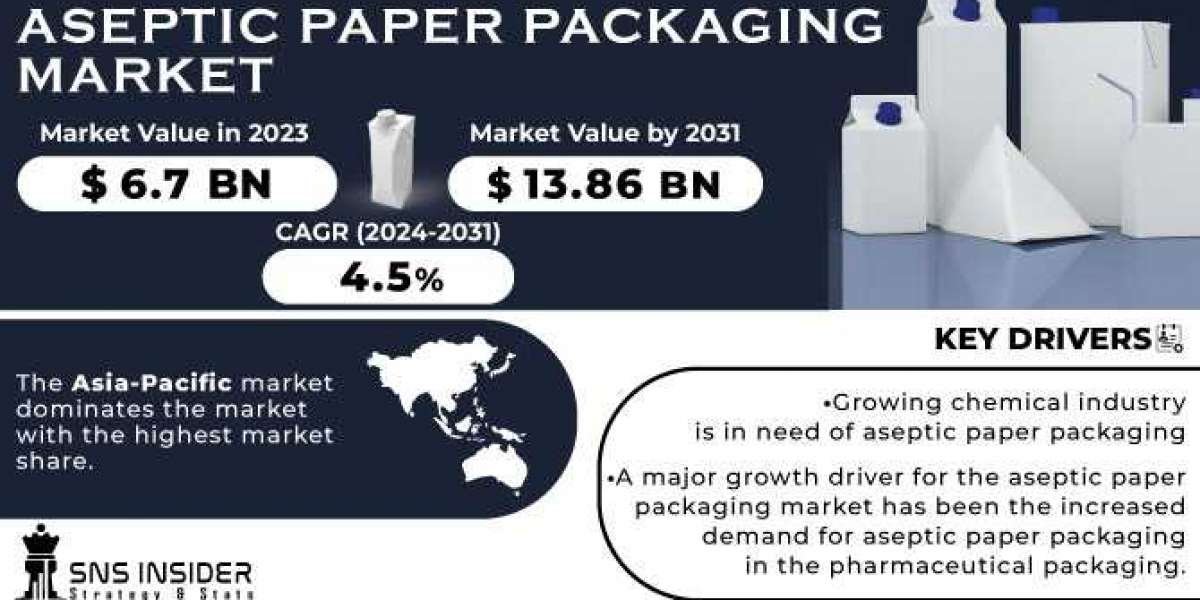The global aseptic paper packaging market Trends is poised for substantial growth, with its market size projected to increase from USD 6.7 billion in 2023 to USD 13.86 billion by 2031, registering a compound annual growth rate (CAGR) of 4.5% over the forecast period of 2024-2031. This growth is driven by the rising demand for sustainable and efficient packaging solutions, particularly in the food beverage, dairy, and pharmaceutical sectors.
Growing Demand for Sustainable Packaging Solutions
The increasing awareness of environmental issues and the growing demand for sustainable packaging are key factors fueling the growth of the aseptic paper packaging market. Aseptic paper packaging, which ensures the long shelf life of products without the need for preservatives or refrigeration, is becoming the preferred choice for manufacturers and consumers alike. This packaging method significantly reduces food waste, carbon footprint, and energy consumption, aligning with global sustainability goals.
Moreover, aseptic paper packaging offers a lightweight, recyclable, and cost-effective alternative to traditional packaging materials. It also enhances product safety and integrity by providing a sterile barrier that protects against contamination, making it particularly suitable for sensitive products like dairy, beverages, and pharmaceuticals.
Download Free Sample Report: https://www.snsinsider.com/sample-request/3141
Innovative Materials and Technology Driving Market Expansion
The aseptic paper packaging market is segmented by material, paper type, packaging type, thickness, and application, each contributing to the market's growth and diversification.
By Material: The market is categorized into paper paperboard, metals, plastics, glass, and others. Paper paperboard dominate the market due to their eco-friendly nature and ability to be easily recycled. This material offers a renewable source for packaging, reducing dependency on non-renewable resources. Metals and plastics are also used in aseptic packaging, particularly in applications requiring additional barrier properties or durability. However, the trend is shifting towards paper-based solutions due to their lower environmental impact.
By Paper Type: Aseptic paper packaging is available in two main types: aseptic bleached paperboard and aseptic coated unbleached kraft paperboard. Aseptic bleached paperboard is widely used due to its superior printability and aesthetic appeal, making it ideal for consumer-facing products. On the other hand, aseptic coated unbleached kraft paperboard is gaining popularity for its natural appearance and strength, offering a sustainable option for packaging heavier or more robust products.
By Packaging Type: The market is segmented into bags pouches, cans, cartons, and others. Cartons are the most commonly used packaging type in the aseptic paper packaging market, favored for their convenience, functionality, and ability to extend product shelf life. The demand for aseptic cartons is particularly high in the food beverage industry, where they are used to package products such as juices, milk, soups, and sauces. Bags pouches are also experiencing growth, driven by their flexibility, lightweight nature, and cost-effectiveness. Cans, while less common in aseptic paper packaging, are utilized in specific applications where added protection and rigidity are required.
By Thickness: The market is categorized into up to 100 microns, 100-200 microns, 200-300 microns, and above 300 microns. Thickness plays a crucial role in determining the durability, strength, and barrier properties of aseptic paper packaging. The 100-200 microns segment is expected to hold the largest market share, offering a balance between flexibility and strength. Packaging with a thickness of 200-300 microns is gaining traction in applications requiring enhanced protection and insulation, such as dairy and pharmaceutical products.
Applications Across Key Industries
The aseptic paper packaging market serves a wide range of applications, with the food beverage, dairy packaging, and pharmaceutical sectors being the primary end-users.
Food Beverage: The food beverage industry is the largest consumer of aseptic paper packaging, driven by the need for packaging solutions that extend shelf life, preserve product freshness, and ensure safety. The demand for aseptic packaging in this sector is expected to continue growing as consumers increasingly seek convenient, ready-to-drink products that can be stored without refrigeration.
Dairy Packaging: Aseptic paper packaging plays a critical role in the dairy industry, where it is used to package products such as milk, cream, yogurt, and dairy-based beverages. The ability of aseptic packaging to maintain the quality and safety of dairy products without the need for preservatives or refrigeration makes it an ideal choice for both manufacturers and consumers.
Pharmaceuticals: The pharmaceutical industry is also a significant end-user of aseptic paper packaging, particularly for products that require sterile packaging to prevent contamination. Aseptic packaging is used for a variety of pharmaceutical products, including liquid medicines, syrups, and intravenous (IV) solutions. The demand for aseptic packaging in this sector is expected to grow as pharmaceutical companies seek packaging solutions that ensure product safety, integrity, and compliance with regulatory standards.
Regional Analysis
The aseptic paper packaging market is geographically segmented into North America, Europe, Asia-Pacific, Latin America, and the Middle East Africa.
North America: North America is a key market for aseptic paper packaging, driven by the strong presence of the food beverage and pharmaceutical industries. The United States and Canada are leading adopters of aseptic packaging, with a focus on sustainability and reducing food waste. The region's well-established supply chain and infrastructure further support the growth of the market.
Europe: Europe is another major market, with countries like Germany, France, and the United Kingdom at the forefront of adopting aseptic packaging solutions. The European Union's stringent regulations on food safety and packaging waste are driving the demand for aseptic paper packaging in the region. Additionally, the growing consumer preference for eco-friendly packaging is contributing to market growth.
Asia-Pacific: The Asia-Pacific region is expected to witness the highest growth rate during the forecast period, driven by rapid urbanization, changing consumer lifestyles, and the expansion of the food beverage industry. Countries like China, India, and Japan are emerging as key markets for aseptic paper packaging, with increasing investments in manufacturing and packaging infrastructure.
Latin America and the Middle East Africa: These regions are also experiencing growth in the aseptic paper packaging market, driven by rising demand for packaged food and beverages, improving healthcare infrastructure, and growing awareness of sustainable packaging solutions.
Competitive Landscape
The aseptic paper packaging market is highly competitive, with key players focusing on innovation, sustainability, and strategic partnerships to gain a competitive edge. Major companies operating in the market include Tetra Pak International S.A., Amcor Plc, SIG Combibloc Group AG, Elopak AS, and Mondi Plc. These companies are investing in research and development to introduce new and improved aseptic packaging solutions that meet the evolving needs of consumers and industries.
Conclusion
The aseptic paper packaging market is set for robust growth over the forecast period, driven by increasing consumer demand for sustainable and efficient packaging solutions, technological advancements, and expanding applications across various sectors. As the world continues to prioritize sustainability and reduce food waste, aseptic paper packaging is poised to play a key role in shaping the future of the packaging industry.
Other Trending Reports
Biodegradable Packaging Regional Analysis
Dunnage Packaging Regional Analysis
Seafood Packaging Regional Analysis
Plastic Waste Management Regional Analysis
About Us:
SNS Insider is one of the leading Market Size research and consulting agencies that dominates the Market Size research industry globally. Our company's aim is to give clients the knowledge they require in order to function in changing circumstances. In order to give you current, accurate Market Size data, consumer insights, and opinions so that you can make decisions with confidence, we employ a variety of techniques, including surveys, video talks, and focus groups around the world.



